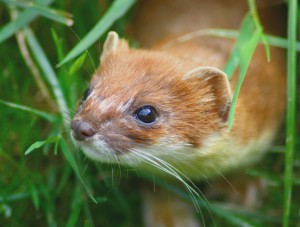 Stoats are larger than the least weasel. Their winter coat is white, but unlike in least weasels, stoats have the tip of their tail black. The species is quite widespread in the region. It inhabits water banks, forest edges, fields, logging and burn-out sites, and sometimes inside forest tracts. Stoats quite often occur in the outskirts of rural settlements, and, at times, in towns. For shelter, they use rotten stumps, hollows in fallen trees, and deadwood. They settle in tree roots, hay ricks and stacks.
Stoats are larger than the least weasel. Their winter coat is white, but unlike in least weasels, stoats have the tip of their tail black. The species is quite widespread in the region. It inhabits water banks, forest edges, fields, logging and burn-out sites, and sometimes inside forest tracts. Stoats quite often occur in the outskirts of rural settlements, and, at times, in towns. For shelter, they use rotten stumps, hollows in fallen trees, and deadwood. They settle in tree roots, hay ricks and stacks.
Stoats predominantly prey on mouse-like rodents, water voles and other small mammals, comprising over 90% of their ration; more seldom they feed on birds, dormant fish and insects. It is a brave and fussy animal, freely chasing prey down rat and mole holes. It is of doubtless benefit for people, therefore the beasts settling near houses, granaries, barns, sheds and the like should be spared. Between 1986 and 1990 the average of 240 stoats per year was procured.
/ * The photos at lake.peipsi.org are cross-posted from commons.wikimedia.org and are used for familiarization purposes only. No commercial use of the photos is allowed. For more information about to use the photos see the originals on commons.wikimedia.org. /


